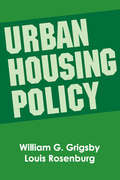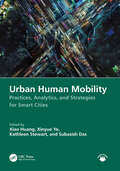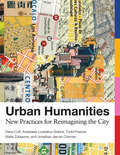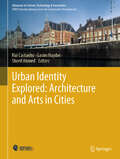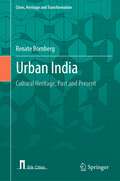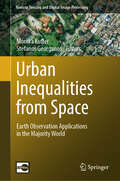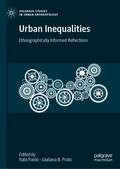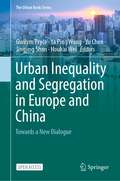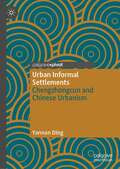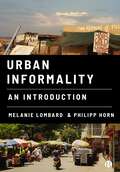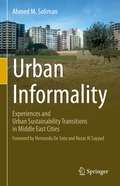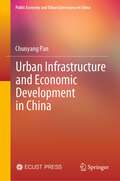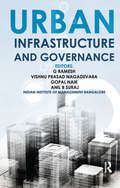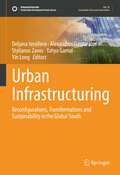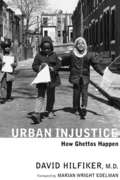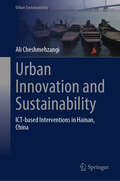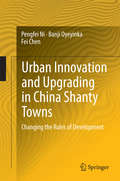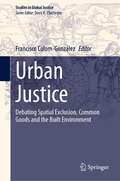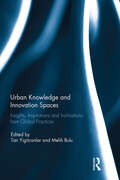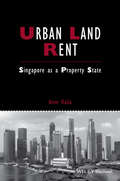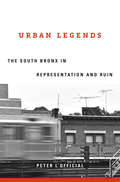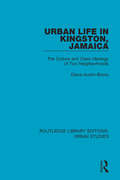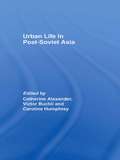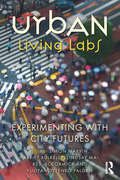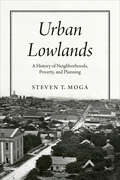- Table View
- List View
Urban Housing Policy
by William G. GrigsbyFor as long as statistics record, housing conditions in the United States have been improving. Housing that only the rich once enjoyed is commonplace today; by today's standards, most of the population was ill-housed at the turn of the century. Amidst this rise, however, inadequate living accommodations for a portion of the population have stubbornly persisted. Many families endure housing deprivations that are severe, even with respect to the norms of earlier years.Development of housing policy requires a blending of technical data, theory, and political and ethical considerations. This study is organized, therefore, around a planning framework. Housing needs and objectives are specified; housing resources are identified; theories of the problem are explored; alternative strategies are reviewed; and one of several possible packages of programs is elaborated in detail. Particular emphasis is placed throughout on the multiplicity of housing and non-housing goals and programs, and on the variety of client groups, which must be taken into consideration in trying to evolve an appropriate role for the public sector in this area of social concern.Specifically, this work begins with a quick sketch of Baltimore and an examination of local problems and policies. This is followed by a description of the dimensions of housing needs. Another chapter studies the low-income market empirically from the perspective of the person whom poor families rely on for housing services - the landlord. An investigation on several theories of slums, decay, and housing abandonment is discussed, and the authors formulate a composite theory that serves as a foundation for policy decisions. The final set of chapters explores in greater detail technical aspects of the proposals contained in the text, and the concluding chapter investigates their political feasibility.
Urban Human Mobility: Practices, Analytics, and Strategies for Smart Cities
by Kathleen Stewart Xinyue Ye Subasish DasThis comprehensive handbook covers human mobility within urban contexts, integrating academic theories with pragmatic insights and offering a detailed analysis of the diverse facets of human mobility and its substantial impact on the urban landscape, economy, and societal structures. It explains key fundamental concepts, methods, and models, presenting an in-depth exploration of predictive analytics, clustering patterns, advanced trajectory embedding techniques, artificial intelligence, machine learning, geographic information systems (GIS), Internet of Things (IoT), and smart city innovations. The authors include many case studies and examples of urban mobility in practice, making the content relatable and practical for educators, students, researchers, and practitioners. Features Provides a multidisciplinary and holistic understanding of urban mobility with systematic introductions and discussions of theory, methods, technologies, tools, and applications. Covers a wide range of real-world case studies of urban mobility in practice globally that include data, programming code, and tools. Discusses cutting-edge technologies involved in mobility data analytics. Addresses practical challenges in data collection and the ethical implications of mobility research, which are crucial for professionals in the field. Offers future directions of human mobility research under the big data and artificial intelligence (AI) revolution. Urban Human Mobility: Practices, Analytics, and Strategies for Smart Cities is for professionals, academics, and upper-level undergraduate and graduate students in the fields of urban planning/design, GIScience, data mining, and social sciences.
Urban Humanities: New Practices for Reimagining the City (Urban and Industrial Environments)
by Todd Presner Dana Cuff Anastasia Loukaitou-Sideris Maite Zubiaurre Jonathan Jae-An CrismanOriginal, action-oriented humanist practices for interpreting and intervening in the city: a new methodology at the intersection of the humanities, design, and urban studies.Urban humanities is an emerging field at the intersection of the humanities, urban planning, and design. It offers a new approach not only for understanding cities in a global context but for intervening in them, interpreting their histories, engaging with them in the present, and speculating about their futures. This book introduces both the theory and practice of urban humanities, tracing the evolution of the concept, presenting methods and practices with a wide range of research applications, describing changes in teaching and curricula, and offering case studies of urban humanities practices in the field.Urban humanities views the city through a lens of spatial justice, and its inquiries are centered on the microsettings of everyday life. The book's case studies report on real-world projects in mega-cities in the Pacific Rim—Tokyo, Shanghai, Mexico City, and Los Angeles—with several projects described in detail, including playful spaces for children in car-oriented Mexico City, a commons in a Tokyo neighborhood, and a rolling story-telling box to promote “literary justice” in Los Angeles.
Urban Identity Explored: Architecture and Arts in Cities (Advances in Science, Technology & Innovation)
by Gasim Hayder Rui Castanho Sherif AhmedThis book systematically examines historical perspectives, meticulously unveiling the nuanced narratives embedded within cityscapes across epochs, providing a comprehensive chronicle of architectural evolution. It conducts a thorough exploration of cultural heritage and transformation, illuminating the dynamic interplay of diverse traditions that breathe vitality into urban landscapes, shaping their unique character. The discourse navigates the intricate terrain of urban sustainability and fragility, meticulously analyzing the delicate equilibrium required to preserve historical integrity while embracing sustainable urban development imperatives. Diverse perspectives on architectural heritage are thoughtfully presented, amplifying the voices often marginalized, and contributing to a more inclusive understanding of our shared history.
Urban India: Cultural Heritage, Past and Present (Cities, Heritage and Transformation)
by Renate BornbergThis book discusses the importance of socio-spatial patterns in cities that are embedded in the cultural heritage and self-understanding of a society, showing that Indian cities follow different urban concepts. In nine episodes (nine is a sacred figure), it highlights the principal influences and social impacts on cities from ancient times to contemporary city developments. As such, it provides planners and architects with insights that can easily be applied in contemporary cities and towns and help foster India’s cultural heritage—a much-needed, but little-discussed approach.Indian cities are the result of various factors, some imposed, others following local traditions that shaped them. They were founded around social needs, landscape conditions and production routines, as well as the religious influences of Hinduism, Buddhism, Jainism, Sikhism, Islam, Christianity and animism. However, Western town-planning models are often implemented, blurring the traditional way of life in cities. For sustainable town development, it is of key importance to find solutions that deal with Indian city models.
Urban Inequalities from Space: Earth Observation Applications in the Majority World (Remote Sensing and Digital Image Processing #26)
by Monika Kuffer Stefanos GeorganosRapid transformation processes occur in the Majority World, where most of the global population is living (estimated around ¾ of the global population), often deprived of access to infrastructure, services, exposed to hazards and degrading environmental conditions. The continuous urbanization in many African, Asian and Latin American cities is coupled with rapid socio-economic and demographic changes in urban, peri-urban, and rural areas. These changes often increase socio-economic fragmentation and existing disparities. According to the United Nations, of the 36 fastest growing cities (with an average annual growth rate of more than 6%), seven are located in Africa, while 28 are found in Asia. On top of the socio-economic transformations, the increasing impact of climate change is expected to increase local vulnerabilities. However, data to understand these transformation processes and relationships are either unavailable, scarce or come with high degrees of uncertainty. Earth Observation information and methods have a great potential to fill data gaps, but they are not exploited to their full potential. Most urban remote sensing studies in the Majority World focus on the primary cities, while not much is known about secondary cities, urbanizing zones or peri-urban areas. Attempting to measure and map environmental and socio-economic phenomena through remote sensing is fundamentally different from extracting bio-physical parameters. In general, studies done by researchers of the Minority World do not sufficiently understand the information needs and capacity demands of the Majority World, especially related to user requirements and ethical perspectives. In this book, we aim to provide an outlook on how Remote Sensing can provide tailored solutions to information needs in urban and urbanizing areas of the Majority World, e.g., in terms socio-economic, environmental and demographic transformation processes. We will provide methodological and application pathways insupport of local and national information needs as well as in support of sustainable development, and specifically, supporting the monitoring of the 17 Sustainable Development Goals (SDGs). The book combines an overview of innovations in applications, methodologies and data use, showing the capacity of Earth Observation to fill global knowledge gaps.
Urban Inequalities: Ethnographically Informed Reflections (Palgrave Studies in Urban Anthropology)
by Italo Pardo Giuliana B. PratoThis collection brings together leading thinkers on human beings in urban spaces and inequalities therein. The contributors eschew conceptual confusion between equality — of opportunity, of access, of the right to compete for whatever goal one chooses to pursue — and levelling. The discussions develop in the belief that old and emerging forms of inequality in urban settings need to be understood in depth, as does the machinery that, as masterfully elucidated by Hannah Arendt, operates behind oppression to sustain power and inequality. Anthropologists and fellow ethnographically-committed social scientists examine socio-economic, cultural and political forms of urban inequality in different settings, helping to address comparatively these dynamics.
Urban Inequality and Segregation in Europe and China: Towards a New Dialogue (The Urban Book Series)
by Houkai Wei Yu Chen Ya Ping Wang Gwilym Pryce Jingjing ShanThis open access book explores new research directions in social inequality and urban segregation. With the goal of fostering an ongoing dialogue between scholars in Europe and China, it brings together an impressive team of international researchers to shed light on the entwined processes of inequality and segregation, and the implications for urban development. Through a rich collection of empirical studies at the city, regional and national levels, the book explores the impact of migration on cities, the related problems of social and spatial segregation, and the ramifications for policy reform. While the literature on both segregation and inequality has traditionally been dominated by European and North American studies, there is growing interest in these issues in the Chinese context. Economic liberalization, rapid industrial restructuring, the enormous growth of cities, and internal migration, have all reshaped the country profoundly. What have we learned from the European and North American experience of segregation and inequality, and what insights can be gleaned to inform the bourgeoning interest in these issues in the Chinese context? How is China different, both in terms of the nature and the consequences of segregation inequality, and what are the implications for future research and policy? Given the continued rise of China’s significance in the world, and its recent declaration of war on poverty, this book offers a timely contribution to scholarship, identifying the core insights to be learned from existing research, and providing important guidance on future directions for policy makers and researchers.
Urban Informal Settlements: Chengzhongcun and Chinese Urbanism
by Yannan DingThis book offers a concise and yet diverse study on the Chengzhongcun. It has a broader scope, both geographical and temporal, than existing works on this topic. The typical Chinese urban informal settlement is related to morphologically similar communities to be found elsewhere in the world. The chapters’ themes were inspired by the methods in historical geography, citizenship studies, and new cultural geography. What is truly unique to this book is that ten years after the basis material of this book was defended, it is enriched with practical experience and first-hand observations of the rapidly changing Chinese city. As urbanization in China slows, this book will interest sociologists, urbanists and scholars of China.
Urban Informality: An Introduction
by Philipp Horn Melanie LombardThis book is the first to provide an introductory overview to the concept of ‘urban informality’, taking an international perspective across the global North and South. It explores theoretical understandings of the term, and looks at how it affects ways of living, such as land use, housing and basic services, working lives and politics. Using a broad range of material to bring the topic to life, including non-conventional sources – such as fiction, poetry, photography, interviews and other media – the book helps students, practitioners and scholars develop learning and research on this topic. The book also includes interjections from diverse voices of practitioners, community activists and regional experts.
Urban Informality: Experiences and Urban Sustainability Transitions in Middle East Cities
by Ahmed M. SolimanThis professional book introduces an analytical framework of urban informality perspectives in the Middle East that is aligned with the Global South. The context of Egypt, Lebanon, and Jordan—in the Middle East— is the transregional focus of this book. In these contexts, the book opens a new arena of academic discussion on the theory and practice of urban informality.Urban Informality: Experiences and Urban Sustainability Transitions in Middle East Cities questions urban informality, "as a site of transitions", interrelated and interlinked with urban sustainability transitions in speedy changes in a given environment. The book presents ‘urban informality sustainability transitions’ regarding resilience and adaptability that require shifts in urban systems. Shifts from a static process to a dynamic process that eradicates the fragmentation between the tensions, anxieties, and pressures of four modes of production, reproduction, consumptions, and distribution of goods and services in the city and its practices. Finally, through eleven chapters, the concluding remarks explore to what extent and how can urban informality transitions be sustainable.
Urban Infrastructure and Economic Development in China (Public Economy and Urban Governance in China)
by Chunyang PanThis book provides an overview of the history, basic concepts, and provision models of infrastructure, significant theories on infrastructure economics, practices at home and abroad that reflect the economic development effects of infrastructure, and four infrastructure economic growth models. Great attention is placed on the domestic front. This book describes and discusses in detail the historical background, development trends, achievements, and challenges of China’s infrastructure from 1949 to 2019, under the classic “supply and demand” analysis framework. From the four perspectives of market integration, open development, people’s livelihood, and endogenous growth, this book carries out an empirical study on how to quantify and make causal inferences about the economic development effects of infrastructure. Based on the conclusion that national governance is of important help to infrastructure provision, this book interprets China’s governance system and its impact on infrastructure provision from the angle of decentralization and offers suggestions on policy optimizing.
Urban Infrastructure and Governance
by G RameshThe book contains a selection of papers on urban governance in its multiple perspectives. It has evolved from the presentations made at the Third International Conference on Public Policy and Management held in 2008.The topics are grouped into several themes: Urban Plan and Governance, Urban Governance through Partnership and Participation, and Financing Urban Infrastructure. With several examples from developing nations, the book dwells into the practical and managerial aspects of urban planning, partnerships, participation, financial mobilization and effective governance. One of the highlights of the book is that it looks at financial mobilization as a strategy for governance and how the financial system in itself can be an instrument of governance.
Urban Infrastructuring: Reconfigurations, Transformations and Sustainability in the Global South (Sustainable Development Goals Series)
by Alexandros Gasparatos Deljana Iossifova Stylianos Zavos Yahya Gamal Yin LongThis book is about urban infrastructuring as the processes linking infrastructural configurations and their components with other social, ecological, political, or otherwise defined systems as part of urbanisation and globalisation in the Global South. It suggests that infrastructuring is essential to urbanisation and that it is entangled with socio-spatio-ecological transformations that often have negative outcomes over time. Furthermore, it argues that infrastructuring requires an ethical positioning in research and practice in order to enhance infrastructural sustainability in the face of intersecting environmental, social and economic crises. “Urban Infrastructuring” is developed in three parts. First, it identifies infrastructural entanglements across various urban and urbanising settings in the Global South. Second, it highlights some of the damaging processes and outcomes of urban infrastructuring and argues that the absence, presence and transformation of infrastructure in the Global South (re-)produces socioecological injustice in the short- and long term. Third, the book argues for a shift of infrastructuring agendas towards more just and sustainable interventions. It suggests that an ethico-politics of care should be embedded in systems approaches to infrastructuring in both research and practice. The edited volume contains contributions from authors with backgrounds in a variety of academic disciplines from the natural and social sciences, engineering and the humanities. It provides valuable insights for anyone concerned with the study, design, planning, implementation and maintenance of urban infrastructures to enhance human well-being and sustainability. It will be of interest to researchers and urban decision-makers alike.
Urban Injustice: How Ghettos Happen
by Marian Wright Edelman David HilfikerDavid Hilfiker has committed his life, both as a writer and a doctor, to people in need, writing about the urban poor with whom he's spent all his days for the last two decades. In Urban Injustice, he explains in beautiful and simple language how the myth that the urban poor siphon off precious government resources is contradicted by the facts, and how most programs help some of the people some of the time but are almost never sufficiently orchestrated to enable people to escape the cycle of urban poverty. Hilfiker is able to present a surprising history of poverty programs since the New Deal, and shows that many of the biggest programs were extremely successful at attaining the goals set out for them. Even so, Hilfiker reveals, most of the best and biggest programs were "social insurance" programs, like Medicare and Social Security, that primarily assisted the middle class, not the poor. Whereas, "public assistance" programs, directed specifically towards the poor, were often extremely effective as far as they went, but were instituted with far less ambitious goals. In a book that is short, sweet, and completely without academic verboseness or pretension, Hilfiker makes a clear path through the complex history of societal poverty, the obvious weaknesses and surprising strengths of societal responses to poverty thus far, and offers an analysis of models of assistance from around the world that might perhaps assist us in making a better world for our children once we decide that is what we must do.
Urban Innovation and Sustainability: ICT-based Interventions in Hainan, China (Urban Sustainability)
by Ali CheshmehzangiThis book is a collection of context-specific ICT-based interventions to achieve sustainability from various perspectives or dimensions. The book is based on case study examples in the strategic context of Hainan, South China. Five ICT-based pilot studies were conducted, surveyed, and analysed in 2021 and 2022. The studies explore impacts on four main sustainability dimensions of environmental, social, economic, and institutional. Several ICT-based interventions are suggested to enhance environmental protection, promote health and support in elderly communities, augment social media for place promotion, create online opportunities for local markets, and help boost local tourism industries. Urban Innovation and Sustainability is an attempt to highlight the positive side of ICT-based interventions in cities and communities. We also need to note the negative side of ICTs, which are partly covered in the case study examples. However, this book focuses on case study pilot examples to promote the nexus between innovation and sustainability. It is essential to explore opportunities that could later be scaled up, transform practices, and help develop context-specific policies. In essence, paradigm shifts, infrastructural development, and human-centric development are necessary. This book&’s findings interest scholars/researchers, practitioners, and authorities in various disciplines of urbanism, urban/human geography, urban studies, planning, innovation, and sustainability.
Urban Innovation and Upgrading in China Shanty Towns
by Fei Chen Pengfei Ni Banji OyeyinkaBy using field survey and World Bank investment project evaluation method, this book investigates the experience of slum rebuilding in Liaoning province, China. It figures out that the experience of Liaoning province is relatively successful and can be of great significance for developing countries and regions. The issue of slums is a huge challenge in the process of global urbanization. The population living in slums is 0. 8 billion worldwide and the number is still growing. International organizations (e. g. , the World Bank) and relevant countries have been working on the rebuilding of slums but only a few succeeded. In recent years, since some scholars believe that government should play dominant role in slums rebuilding, Liaoning province has developed a systematical model in slums rebuilding from 2005. This model emphasizes the guidance of government, market functions and society involvement. With the application of the new model, Liaoning province has improved 2. 11 million people's living conditions from 2005 to 2010. By introducing the conditions, history, rebuilding process and rebuilding methods of Liaoning slums, this book provides new information and data for slum rebuilding decision makers and researchers.
Urban Justice: Debating Spatial Exclusion, Common Goods and the Built Environment (Studies in Global Justice #23)
by Francisco Colom-GonzálezThis book outlines an interdisciplinary normative framework that makes sense of the historical transformation of cities and helps to assess contemporary urban conditions and policies for the built environment. This normative framework is embedded in what the editor and authors have termed 'urban justice'. As is widely acknowledged, the urban condition has become the inescapable horizon of modern life. Urban relations now permeate the lives of the majority of the world's population. Even if urbanization as a global process seems to have reached its zenith, there is no end in sight to the growth of cities. This is a fact that political theory must come to terms with when debating justice. To address this, this book is divided into three sections, each dealing with the spatial dimension of social agency, normative ideas about inclusive urban design, and contemporary processes that threaten to erode the urban fabric. In doing so, it helps one to normatively evaluate the spatial materialization of social relations in the city, so the view of urban habitat as a shared good becomes prominent. This book is of interest to scholars of urban studies, social sciences, political theory, and social philosophy, as well as those interested in contemporary urban processes in general.
Urban Knowledge and Innovation Spaces: Insights, Inspirations and Inclinations from Global Practices
by Tan YigitcanlarThe expansion of knowledge economy, globalization, and economic competitiveness has imparted importance of knowledge and innovation in local economies worldwide. As a result, integrating knowledge generation and innovation considerations in urban planning and development processes has become an important agenda for establishing sustainable growth and long-term competitiveness of contemporary cities. Today, making space and place that concentrate on knowledge generation and innovation is a priority for many cities across the globe. Urban knowledge and innovation spaces are integrated centres of knowledge generation, learning, commercialization and lifestyle. In other words, they are high-growth knowledge industry and worker clusters, and distinguish the functional activity in an area, where agglomeration of knowledge and technological activities has positive externalities for the rest of the city as well as firms located there. Urban knowledge and innovation spaces are generally established with two primary objectives in mind: to be a seedbed for knowledge and technology and to play an incubator role nurturing the development and growth of new, small, high-technology firms; and to act as a catalyst for regional economic development that promotes economic growth and contributes to the development of the city as a ‘knowledge or innovative city’. This book contains chapters reporting investigation findings on different aspects of urban knowledge and innovation spaces, such as urban planning and design, innovation systems, urban knowledge management, and regional science. It was originally published as a special issue of the Journal of Urban Technology.
Urban Land Rent: Singapore as a Property State (IJURR Studies in Urban and Social Change Book Series)
by Anne HailaIn Urban Land Rent, Anne Haila uses Singapore as a case study to develop an original theory of urban land rent with important implications for urban studies and urban theory. Provides a comprehensive analysis of land, rent theory, and the modern city Examines the question of land from a variety of perspectives: as a resource, ideologies, interventions in the land market, actors in the land market, the global scope of land markets, and investments in land Details the Asian development state model, historical and contemporary land regimes, public housing models, and the development industry for Singapore and several other cities Incorporates discussion of the modern real estate market, with reference to real estate investment trusts, sovereign wealth funds investing in real estate, and the fusion between sophisticated financial instruments and real estate
Urban Legends: The South Bronx in Representation and Ruin
by Peter L'OfficialA cultural history of the South Bronx that reaches beyond familiar narratives of urban ruin and renaissance, beyond the “inner city” symbol, to reveal the place and people obscured by its myths. For decades, the South Bronx was America’s “inner city.” Synonymous with civic neglect, crime, and metropolitan decay, the Bronx became the preeminent symbol used to proclaim the failings of urban places and the communities of color who lived in them. Images of its ruins—none more infamous than the one broadcast live during the 1977 World Series: a building burning near Yankee Stadium—proclaimed the failures of urbanism. Yet this same South Bronx produced hip hop, arguably the most powerful artistic and cultural innovation of the past fifty years. Two narratives—urban crisis and cultural renaissance—have dominated understandings of the Bronx and other urban environments. Today, as gentrification transforms American cities economically and demographically, the twin narratives structure our thinking about urban life. A Bronx native, Peter L’Official draws on literature and the visual arts to recapture the history, people, and place beyond its myths and legends. Both fact and symbol, the Bronx was not a decades-long funeral pyre, nor was hip hop its lone cultural contribution. L’Official juxtaposes the artist Gordon Matta-Clark’s carvings of abandoned buildings with the city’s trompe l’oeil decals program; examines the centrality of the Bronx’s infamous Charlotte Street to two Hollywood films; offers original readings of novels by Don DeLillo and Tom Wolfe; and charts the emergence of a “global Bronx” as graffiti was brought into galleries and exhibited internationally, promoting a symbolic Bronx abroad. Urban Legends presents a new cultural history of what it meant to live, work, and create in the Bronx.
Urban Life in Kingston Jamaica: The Culture and Class Ideology of Two Neighborhoods (Routledge Library Editions: Urban Studies)
by Diane Austin-BroosThis book, first published in 1984, recounts the daily life, the politics, religion and leisure pursuits of Jamaicans in working- and middle-class Kingston. The study is based upon the author’s observations of life in Selton Town and Vermount, two neighborhoods of Kingston, between 1971 and 1982. The author analyses the local social conflicts and ideologies, thereby, demonstrating how larger issues of class domination and cultural hegemony pervade neighbourhood life. The study provides a detailed contextual account of the significance of belonging to different classes. It provides a different perspective of Caribbean anthropology combining the techniques of ethnography and political economy.
Urban Life in Post-Soviet Asia
by Caroline Humphrey Victor Buchli Catherine AlexanderCapturing a unique historical moment, this book examines the changes in urban life since the collapse of the Soviet Union from an ethnographic perspective, thus addressing significant gaps in the literature on cities, Central Asia and post-socialism. It encompasses Tashkent, Almaty, Astana and Ulan-Ude: four cities with quite different responses to the fall of the Soviet Union. Each chapter takes a theme of central significance across this huge geographical terrain, addresses it through one city and contextualizes it by reference to the other sites in this volume. The structure of the book moves from nostalgia and memories of the Soviet past to examine how current changes are being experienced and imagined through the shifting materialities, temporalities and political economies of urban life. Privatization is giving rise to new social geographies, while ethnic and religious sensibilities are creating emergent networks of sacred sites. But, however much ideologies are changing, cities also provide a constant lived mnemonic of lost configurations of ideology and practice, acting as signposts to bankrupted futures. Urban Life in Post-Soviet Asia provides a detailed account of the changing nature of urban life in post-Soviet Asia, clearly elucidating the centrality of these urban transformations to citizens’ understandings of their own socio-economic condition.
Urban Living Labs: Experimenting with City Futures
by Simon Marvin, Harriet Bulkeley, Lindsay Mai, Kes McCormick and Yuliya Voytenko PalganAll cities face a pressing challenge – how can they provide economic prosperity and social cohesion while achieving environmental sustainability? In response, new collaborations are emerging in the form of urban living labs – sites devised to design, test and learn from social and technical innovation in real time. The aim of this volume is to examine, inform and advance the governance of sustainability transitions through urban living labs. Notably, urban living labs are proliferating rapidly across the globe as a means through which public and private actors are testing innovations in buildings, transport and energy systems. Yet despite the experimentation taking place on the ground, we lack systematic learning and international comparison across urban and national contexts about their impacts and effectiveness. We have limited knowledge on how good practice can be scaled up to achieve the transformative change required. This book brings together leading international researchers within a systematic comparative framework for evaluating the design, practices and processes of urban living labs to enable the comparative analysis of their potential and limits. It provides new insights into the governance of urban sustainability and how to improve the design and implementation of urban living labs in order to realise their potential.
Urban Lowlands: A History of Neighborhoods, Poverty, and Planning (Historical Studies of Urban America)
by Steven T. MogaIn Urban Lowlands, Steven T. Moga looks closely at the Harlem Flats in New York City, Black Bottom in Nashville, Swede Hollow in Saint Paul, and the Flats in Los Angeles, to interrogate the connections between a city’s actual landscape and the poverty and social problems that are often concentrated at its literal lowest points. Taking an interdisciplinary perspective on the history of US urban development from the nineteenth to the mid-twentieth century, Moga reveals patterns of inequitable land use, economic dispossession, and social discrimination against immigrants and minorities. In attending to the landscapes of neighborhoods typically considered slums, Moga shows how physical and policy-driven containment has shaped the lives of the urban poor, while wealth and access to resources have been historically concentrated in elevated areas—truly “the heights.” Moga’s innovative framework expands our understanding of how planning and economic segregation alike have molded the American city.
